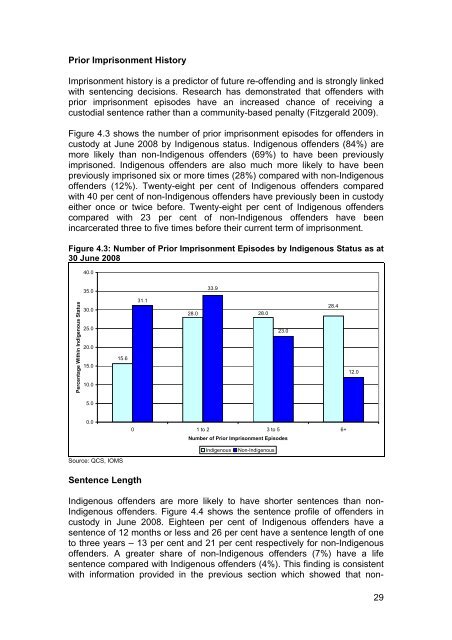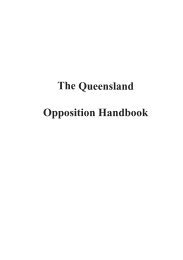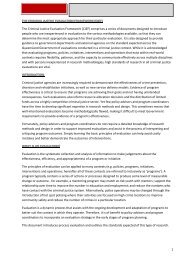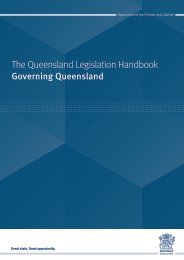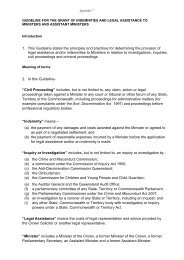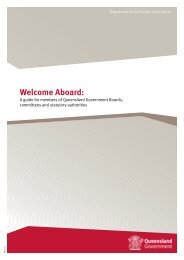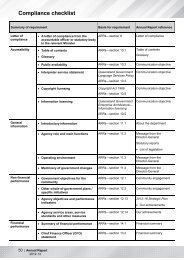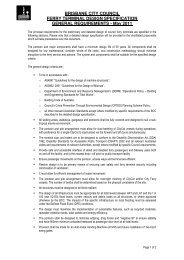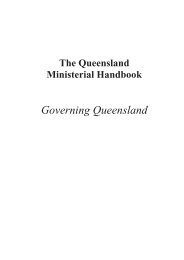Rehabilitative needs and treatment of Indigenous offenders in ...
Rehabilitative needs and treatment of Indigenous offenders in ...
Rehabilitative needs and treatment of Indigenous offenders in ...
Create successful ePaper yourself
Turn your PDF publications into a flip-book with our unique Google optimized e-Paper software.
Prior Imprisonment HistoryImprisonment history is a predictor <strong>of</strong> future re-<strong>of</strong>fend<strong>in</strong>g <strong>and</strong> is strongly l<strong>in</strong>kedwith sentenc<strong>in</strong>g decisions. Research has demonstrated that <strong>of</strong>fenders withprior imprisonment episodes have an <strong>in</strong>creased chance <strong>of</strong> receiv<strong>in</strong>g acustodial sentence rather than a community-based penalty (Fitzgerald 2009).Figure 4.3 shows the number <strong>of</strong> prior imprisonment episodes for <strong>of</strong>fenders <strong>in</strong>custody at June 2008 by <strong>Indigenous</strong> status. <strong>Indigenous</strong> <strong>of</strong>fenders (84%) aremore likely than non-<strong>Indigenous</strong> <strong>of</strong>fenders (69%) to have been previouslyimprisoned. <strong>Indigenous</strong> <strong>of</strong>fenders are also much more likely to have beenpreviously imprisoned six or more times (28%) compared with non-<strong>Indigenous</strong><strong>of</strong>fenders (12%). Twenty-eight per cent <strong>of</strong> <strong>Indigenous</strong> <strong>of</strong>fenders comparedwith 40 per cent <strong>of</strong> non-<strong>Indigenous</strong> <strong>of</strong>fenders have previously been <strong>in</strong> custodyeither once or twice before. Twenty-eight per cent <strong>of</strong> <strong>Indigenous</strong> <strong>of</strong>fenderscompared with 23 per cent <strong>of</strong> non-<strong>Indigenous</strong> <strong>of</strong>fenders have been<strong>in</strong>carcerated three to five times before their current term <strong>of</strong> imprisonment.Figure 4.3: Number <strong>of</strong> Prior Imprisonment Episodes by <strong>Indigenous</strong> Status as at30 June 200840.035.033.9Percentage With<strong>in</strong> <strong>Indigenous</strong> Status30.025.020.015.010.015.631.128.028.023.028.412.05.00.00 1 to 2 3 to 5 6+Number <strong>of</strong> Prior Imprisonment EpisodesSource: QCS, IOMS<strong>Indigenous</strong>Non-<strong>Indigenous</strong>Sentence Length<strong>Indigenous</strong> <strong>of</strong>fenders are more likely to have shorter sentences than non-<strong>Indigenous</strong> <strong>of</strong>fenders. Figure 4.4 shows the sentence pr<strong>of</strong>ile <strong>of</strong> <strong>of</strong>fenders <strong>in</strong>custody <strong>in</strong> June 2008. Eighteen per cent <strong>of</strong> <strong>Indigenous</strong> <strong>of</strong>fenders have asentence <strong>of</strong> 12 months or less <strong>and</strong> 26 per cent have a sentence length <strong>of</strong> oneto three years – 13 per cent <strong>and</strong> 21 per cent respectively for non-<strong>Indigenous</strong><strong>of</strong>fenders. A greater share <strong>of</strong> non-<strong>Indigenous</strong> <strong>of</strong>fenders (7%) have a lifesentence compared with <strong>Indigenous</strong> <strong>of</strong>fenders (4%). This f<strong>in</strong>d<strong>in</strong>g is consistentwith <strong>in</strong>formation provided <strong>in</strong> the previous section which showed that non-29


